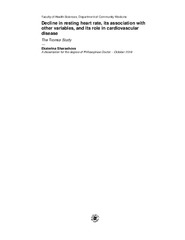Decline in resting heart rate, its association with other variables, and its role in cardiovascular disease The Tromsø Study
Permanent lenke
https://hdl.handle.net/10037/10992Dato
2017-02-10Type
Doctoral thesisDoktorgradsavhandling
Forfatter
Sharashova, EkaterinaSammendrag
Objective: To investigate secular trends in RHR in the general population of Tromsø, Northern Norway over the last decades, and to explore the role of RHR and long-term changes in RHR in CVD and mortality.
Methods: Participants from four surveys of the Tromsø Study conducted between 1986 and 2008 were included in these analyses (n=34 751). RHR in these participants was measured with an automated Dinamap device and resultant data were linked to validated information on incident myocardial infarction, atrial fibrillation, ischemic stroke, cardiovascular death and total death. Statistical methods included mixed models analysis, fractional polynomials, and trajectory analysis.
Main results: Over 22 years of observation, the mean age-adjusted RHR declined from 73.4 to 64.7 beats per minute in men, and from 78.3 to 66.4 beats per minute in women; 17.4% of the decline in men and 16.1% of the decline in women was attributable to favourable changes in other cardiovascular risk factors. In men, elevated RHR independently predicted the risk of myocardial infarction, atrial fibrillation, and cardiovascular death. In women, the associations with myocardial infarction and total death were similar to those in men, and we found a J-shaped association with ischemic stroke. Having a constantly elevated RHR or a RHR that increased from moderate to high over 15 years increased the risk of myocardial infarction, cardiovascular death, and total death in men, whereas estimates in women were insignificant.
Conclusions: Over the last decades RHR has declined substantially, and this decline has occurred to a large extent independently of other cardiovascular risk factors. RHR independently predicts the risk of CVD and mortality though there are sex differences. Long-term changes in RHR provide additional information for risk assessment. Thus, RHR is as an independent cardiovascular risk factor, and as such it should be monitored and used in risk assessments by both people themselves and by health professionals. RHR is a modifiable cardiovascular risk factor; however it is unclear whether people could benefit from RHR-lowering interventions.
Beskrivelse
Paper I: Sharashova, E., Wilsgaard, T., Brenn, T.: “Resting heart rate on the decline: the Tromsø Study 1986-2007”. Available in Int J Epidemiol 2015, 44(3):1007-1017.
Paper II: Sharashova, E., Wilsgaard, T., Mathiesen, E. B., Løchen, M. L., Njølstad, I., Brenn, T.: “Resting heart rate predicts incident myocardial infarction, atrial fibrillation, ischaemic stroke and death in the general population: the Tromsø Study”. Available in J Epidemiol Community Health 2016, 70(9):902-909.
Paper III: Sharashova, E., Wilsgaard, T., Løchen, M. L., Mathiesen, E. B., Njølstad, I., Brenn, T.: “Resting heart rate trajectories and myocardial infarction, atrial fibrillation, ischemic stroke and death in the general population: the Tromsø Study”. (Manuscript).
Forlag
UiT The Arctic University of NorwayUiT Norges arktiske universitet
Serie
ISM skriftserie; 177Metadata
Vis full innførselSamlinger
- Doktorgradsavhandlinger (Helsefak) [770]
- ISM skriftserie [161]
Følgende lisensfil er knyttet til denne innførselen:


 English
English norsk
norsk
